Venue hire
Middlesex Guildhall Art Collection
The collection commemorates many former Lords Lieutenants, judges, magistrates and politicians, and includes a rare opportunity to compare portraits of the 1st Duke of Northumberland by both Gainsborough and Reynolds.
- Henry Pownall, by Eden Upton Eddis
- Duke of Northumberland, by Thomas Gainsborough
- Earl of Northumberland, by Sir Joshua Reynolds
- William Mainwaring, by Gainsborough Dupont
- Baptist Hicks, attributed to Paul van Somer
- George III tapestry
- Location of art works at the UKSC
Henry Pownall, by Eden Upton Eddis
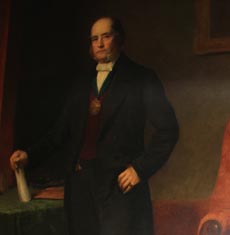
J.G. Henry Pownall (1792-1880) was a JP and Chairman of Middlesex Quarter Sessions. He was a generous philanthropist, supporting the construction of new churches and schools, and giving money to the campaign against slavery.
Details
Oil on canvas
93¼ x 57 in. (2368 x 1448 mm)
Frame style: gallery
A plaque attached to the frame reads ‘Henry Pownall Esqre’. This painting is displayed in meeting room 3 of The Supreme Court building.
About the sitter
J.G. Henry Pownall (?1792-1871) was a JP and Chairman of Middlesex Quarter Sessions. He was a generous philanthropist, supporting the construction of new churches and schools, and giving money to the campaign against slavery.
As a devoted Anglo-catholic, he was a strong opponent of the Papacy and the introduction of the Apocrypha into British Bibles. His son, Frederick Hyde Pownall (1832-1907) was an architect of the second Middlesex Guildhall and Wandsworth Prison.
About the artist
Eden Upton Eddis (1812-1901) learnt to draw at a school run by Henry Sass in Bloomsbury before being admitted to the Royal Academy Schools in 1828 where he won a silver medal.
Having toured Europe, he exhibited at the Royal Academy from 1834 to 1883. Initially he specialised in landscapes, but gradually launched himself as a popular portrait painter. In 1883 he began to go deaf, withdrew from London society, and moved from Harley Street to Shalford near Guildford in Surrey, where he continued to paint.
Conservation
2009: Both painting and frame were assessed as stable, but would benefit from future conservation and restoration. The painting was re-framed with measures to provide protection from dust at the reverse.
Duke of Northumberland, by Thomas Gainsborough
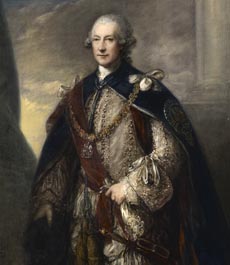
Hugh Percy, 1st Duke of Northumberland (c1714-1786) was a prominent politician who served as Privy Counsellor from 1762, and Lord Lieutenant of Middlesex from 1763 to 1786.
Details
Oil on canvas
90½ x 59 in. (2299 x 1499 mm)
Frame style: Neoclassic, with entwined laurel-stem guilloche between pearled and palmette-wrapped borders, designed in the George III ‘antique’ manner of the 1760s.
This painting was exhibited at the Royal Academy in 1783. It is now displayed in the law library of The Supreme Court building.
About the sitter
Hugh Percy, 1st Duke of Northumberland (c1714-1786) was a prominent politician who served as Privy Counsellor from 1762, Lord Lieutenant of Middlesex from 1763 to 1786.
After marrying an indirect heiress of the Percy family, one of England’s leading landowners, he spent much effort embellishing Northumberland House, Sion House and Alnwick Castle, employing James Paine, Robert Adam and Capability Brown.
One of his illegitimate children, James Smithson (1764-1829) was a chemist and mineralogist who founded the Smithsonian Institution in Washington.
About the artist
Thomas Gainsborough (c 1727-1788) was one of the most famous portrait and landscape painters of 18th century Britain.
Having trained in his early teens under the London engraver Hubert Gravelot, he developed his client base from local merchants and squires to important society commissions including George III and Queen Charlotte. In 1783 he quarrelled with the Royal Academy: in 1784 the King had to appoint Sir Joshua Reynolds as royal painter even though he seemed to prefer Gainsborough.
Gainsborough was both technically proficient and highly experimental, painting very thinly with long, broad brushes. Unlike many contemporaries, he only had one assistant, his nephew Gainsborough Dupont who also contributed to the Middlesex Art Collection.
Conservation
2007/9: Discoloured varnish and disfiguring over paint was removed and the painting was re-varnished. A technical report on its pigments, media etc was carried out by the Department of Conservation & Technology at the Courtauld Institute of Art, which will contribute to the wider knowledge of Gainsborough’s technique. The frame also underwent substantial restoration, with losses repaired and features re-created where they were missing, and top layers of non-original gilding were removed to a near-original layer.
2009: The painting was re-framed with measures to provide protection from dust at the reverse.
The Earl of Northumberland, by Sir Joshua Reynolds
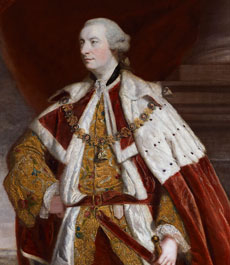
Hugh Percy, 1st Duke of Northumberland (c1714-1786) was a prominent politician who served as Privy Counsellor from 1762, and Lord Lieutenant of Middlesex from 1763 to 1786.
Details
Oil on canvas
94 x 58 in. (2388 x 1473 mm)
Frame style: Rococo, carved and gilded, by the famous firm of Thomas Chippendale.
This painting is displayed in Court Room 3 of The Supreme Court building.
About the sitter
Hugh Percy, 1st Duke of Northumberland (c1714-1786) was a prominent politician who served as Privy Counsellor from 1762, Lord Lieutenant of Middlesex from 1763 to 1786. This portrait was painted in 1762, before he received his full Dukedom in 1766.
After marrying an indirect heiress of the Percy family, one of England’s leading landowners, he spent much effort embellishing Northumberland House, Sion House and Alnwick Castle, employing James Paine, Robert Adam and Capability Brown.
One of his illegitimate children, James Smithson (1764-1829) was a chemist and mineralogist who founded the Smithsonian Institution in Washington.
About the artist
Sir Joshua Reynolds (1723-1792) was one of the most important and influential 18th century English painters, specialising in portraits and promotion of the ‘Grand Style’.
Apprenticed to the fashionable London portrait painter, Thomas Hudson, he studied in Italy, France and the Netherlands. When in London, his circle included Dr Johnson, Oliver Goldsmith, Edmund Burke, David Garrick and fellow artist Angelica Kaufmann.
He was a prolific and high earning portraitist, who may have painted as many as three thousand portraits of the famous and wealthy. He was a founder member of the Royal Academy and was made the first President in 1768, a position he held until his death.
Unfortunately many of his pictures suffered from premature and unusual cracking, with colours fading in ways that often make it difficult to judge the original appearance.
Conservation
2004/5: Discoloured varnish was removed, with some filling of old damages, re-touching and re-varnishing. The frame was also fully restored and re-gilded.
2008/9: Strip lining was carried out using polyester, to support the brittle original tacking edge. The painting was re-varnished, the frame was cleaned very gently and thoroughly, and some minor repairs and re-gilding were carried out.
2009: The painting was re-framed with measures to provide protection from dust at the reverse.
William Mainwaring, by Gainsborough Dupont
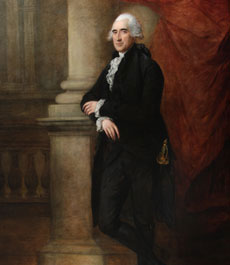
William Mainwaring was MP for Middlesex from 1784, and served as Chairman of the Middlesex and Westminster Quarter Sessions.
Details
Oil on canvas
93 x 60½ in. (2362 x 1537 mm)
Frame style: Gallery
This painting was exhibited at the Royal Academy, 1793. It is now displayed in Court Room 3 of The Supreme Court building.
About the sitter
William Mainwaring was MP for Middlesex from 1784, and served as Chairman of the Middlesex and Westminster Quarter Sessions.
He became embroiled in a dispute with the radical Francis Burdett when he refused demands for an inquiry into prison abuses. This long-running dispute was fought out in elections and reflects the inflammatory nature of much late eighteenth century politics.
About the artist
Gainsborough Dupont (1754-1797) was a painter and mezzotint engraver. As a nephew of Thomas Gainsborough through his mother’s family, he was apprenticed to his uncle in Bath in 1772, and moved with him to London.
After studying at the Royal Academy Schools, he became his uncle’s studio assistant, making engravings and small-scale copies of his uncle’s works. Seemingly, he was diffident and modest, yet from 1790, he exhibited both portraits and landscapes at the Royal Academy.
After Thomas Gainsborough died in 1788, Dupont continued to produce engravings in his uncle’s studio. From this time, his own painting became more personal, but it is still difficult to distinguish much of his earlier work from that of his uncle.
Conservation
2006: The frame was cleaned and some repairs to the flaking gilding were carried out.
2007/8: More work was carried out on the frame to replace the running leaf pattern where necessary.
2008/9: The painting’s varnish was removed; it had been heavily over-painted probably to disguise severe drying cracks and wear (from earlier cleaning regimes). Retouching was carried out using a varnish and dry pigments, and the painting was re-varnished. The brittle tacking edge of the canvas was strengthened by strip lining.
2009: The painting was re-framed with measures to provide protection from dust at the reverse.
Sir Baptist Hicks, attributed to Paul van Somer
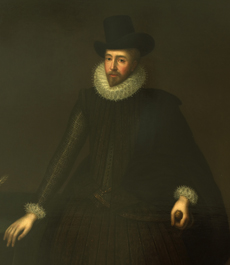
Sir Baptist Hicks, 1st Viscount Campden (?1551-1629) was one of the most important money lenders to the Stuart kings. James I knighted him in 1603, and he was appointed a Deputy Lieutenant for Middlesex in 1625.
Details
Oil on canvas
84¼ x 53 in. (2146 x 1346 mm)
Frame style: Bolection
This painting is displayed outside Court Room 3 of The Supreme Court building.
About the sitter
Sir Baptist Hicks, 1st Viscount Campden (?1551-1629) was one of the most important money lenders to the Stuart kings. James I knighted him in 1603, and he was appointed a Deputy Lieutenant for Middlesex in 1625.
In 1611-12, he funded the building of a Sessions House for the Middlesex magistrates, which was known as Hicks Hall. He left substantial legacies to charitable causes; parish churches, the building of a market house, the endowment of almshouses in Campden, Gloucestershire, and bequests to the poor, both in Campden and in London.
About the artist
Paul (Pauwels) van Somer (1577/8-1621/2) was a portrait painter who was probably born in Antwerp. Between 1612 and 1615, he was painting in Leiden, The Hague and Brussels, but none of his work is recorded before he arrived in London.
By the autumn of 1615, he had settled in the St Martin’s Lane area with two other court painters from the Netherlands, Daniel Mytens and Abraham van Blyenberch. An important contemporary record of artists’ materials and techniques by James I’s Swiss physician praises his “incomparable varnish”.
Conservation
2007/8: Some minor repairs were carried out to the frame, and it was hoped that the painting could be fully cleaned. Unfortunately, large areas of the background had been re-painted (over damage caused by a malfunction in the drying of the paint layer). Removing this over paint could not be justified, as the considerable work involved would not have substantially improved the appearance of the painting. Instead, the uppermost, glossy and yellow layer of varnish was reduced by friction, and the painting was re-varnished.
2009: The painting was re-framed with measures to provide protection from dust at the reverse.
George III tapestry
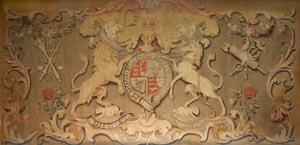
This ornate tapestry is woven with the Arms and Cypher of George III, the badges of the United Kingdom and the motto of the Order of the Garter.
Details
Tapestry
Dated circa 1760
97 x 193½ in. (2464 x 4915 mm)
This tapestry is displayed in the librarian’s office of The Supreme Court building.
About the tapestry
The tapestry is woven with the Arms and Cypher of George III, within a polychrome cartouche of Roman foliage, flowered with the badges of the United Kingdom and festooned with garlands and beribboned trophies uniting the emblems of Government, Justice, Arts and Commerce.
This Coat of Arms is the one used from 1714 to 1801. The same crest appears on the headboard of the bed in which George III slept at Goodwood House during this period.
The trophies in the panel include Roman fasces, Minerva’s helmet and Mercury’s caduceus. These all allude to good government and optimism at the beginning of George III’s reign.
The tapestry bears the motto of the Order of the Garter: “HONI SOIT-QUI.MAL.Y.PENSE.”: “Shamed be he who thinks evil of it”.
On the lower right, the maker’s signature is visible: ‘T.CO SHAM’
George III was born in 1738, crowned in 1760 and died in 1820. The Coat of Arms changed in 1801 to 1816 and then again in 1816 to 1837.
Conservation
2007/9: The tapestry underwent major conservation treatment: cleaning to remove heavy soiling and staining, stabilising the fabric by restoring the pH level as close to normal as possible, repairs as necessary, reducing distortions in the drape and re-backing. Over the years, the tapestry has faded considerably. A special box with a blind has been designed to protect the tapestry from further light damage and dust.
Location of art works at the UKSC
The following art works can be viewed whenever the court building is open.
Court 1
- Arthur Wellesley, 2nd Duke of Wellington by Ethel Mortlock
- Lord Bingham by David Poole
- Sir John Fielding by Nathanial Hone
- Sir Montague Sharpe by George Spencer Watson
Court 3
- Earl of Northumberland by Sir Joshua Reynolds (frame by Chippendale)
- William Mainwaring by Gainsborough Dupont
- John Lord Campbell by Thomas Woolnoth
- Richard Bethell by by Michael Gordigiani
- Lord Haldane by Arthur Stockdale Cope
- Edward Macnaughton by Hughde Twenebrokes Glazebrook
- John Simon, Viscount Simon by Frank Salisbury
- Robert Threshie Reid, Earl Loreborn by George Reid
- Sir Baptist Hicks attributed to Paul van Somer
Exhibition Space
- Badges of High Sheriff and Westminster Sessions
- Commemorative Documents of Middlesex Guildhall
The following can be viewed on public Open Days
Library
- Hugh Percy, 1st Duke of Northumberland by Thomas Gainsborough
- Herbrand Arthur Russell, 11th Duke of Bedford by John Collier
- James Brownlow William Cecil 2nd Marquis of Salisbury by Eden Upton Eddis
Library balcony
- George Henry Byng 3rd Earl of Strafford
- George III tapestry dated circa
The following can be viewed by appointment only
Please contact our enquiries team
Telephone: 020 7960 1500 or 1900.
- Charles I by John Reilly (1919) after Van Dyck
- Francis Const by Henry William Pickersgill (as identified by contributors to Art UK's Art Detective website)
- Francis Const by unknown artist of the 'English School'
- Henry Pownell by Eden Upton Eddis
- Hugh Percy, 2nd Duke of Northumberland by Andres van Rymsdyk
- Portrait of a Cleric -by an unkown artist of the 'English School'
- Portrait of a Gentleman - unkown artist of the 'English School' 19th century
- Portrait of a Judge - Unknown
- Sir Francis Brockman Morley by John Collier
- Sir Gilford Craig by Harold Knight
- Sir Howard Button by Margaret Lindsay Williams
- Sir James Nicoll McAdam by an unkown artist of the 'English school'
- Sir John Fielding - after the Rev Matthew Peters R.A. by W. Dickenson
- Sir Ralph Littler by Beatrice Offor
- Sir Ralph Littler by Hubert von Herkomer Offor
- Sir Thomas Forster by Thomas Cantrell Dugdale
- Town Clerk by Herbert William Piper
- Unknown man (sculpture bust) by William Merrett
- William Henry Bodkin by John Prescott Knight
- William Regester by John Collier